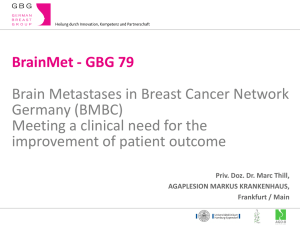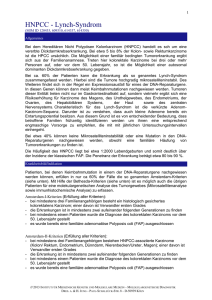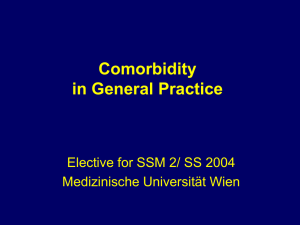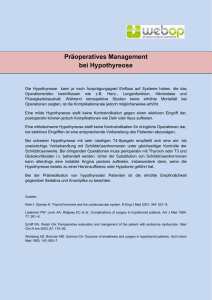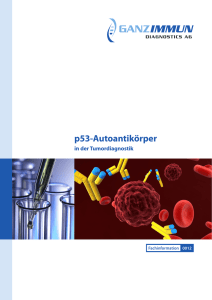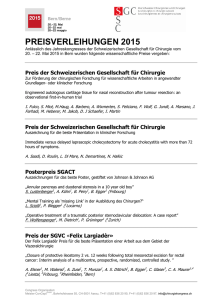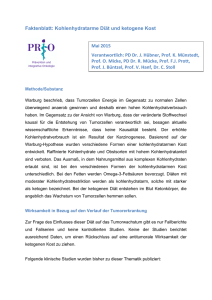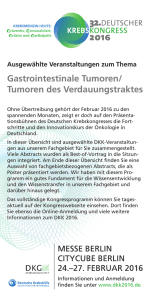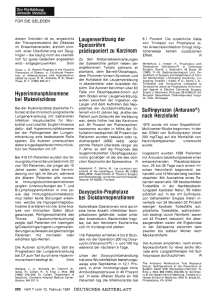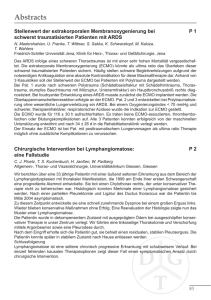Werbung
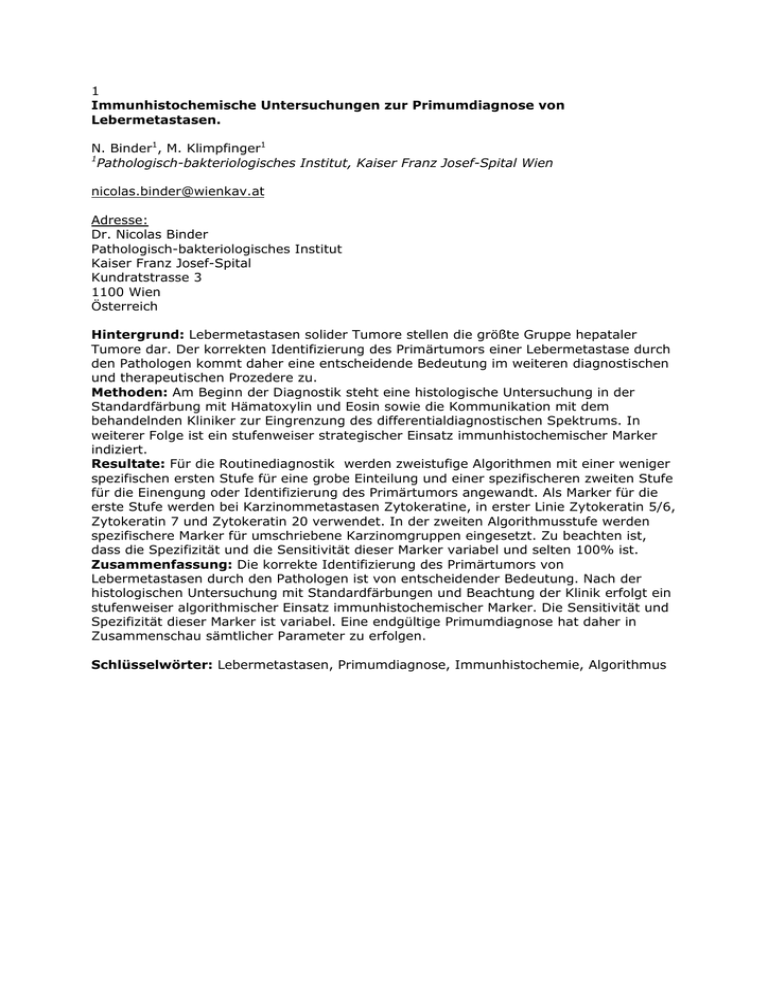
1 Immunhistochemische Untersuchungen zur Primumdiagnose von Lebermetastasen. N. Binder1, M. Klimpfinger1 Pathologisch-bakteriologisches Institut, Kaiser Franz Josef-Spital Wien 1 [email protected] Adresse: Dr. Nicolas Binder Pathologisch-bakteriologisches Institut Kaiser Franz Josef-Spital Kundratstrasse 3 1100 Wien Österreich Hintergrund: Lebermetastasen solider Tumore stellen die größte Gruppe hepataler Tumore dar. Der korrekten Identifizierung des Primärtumors einer Lebermetastase durch den Pathologen kommt daher eine entscheidende Bedeutung im weiteren diagnostischen und therapeutischen Prozedere zu. Methoden: Am Beginn der Diagnostik steht eine histologische Untersuchung in der Standardfärbung mit Hämatoxylin und Eosin sowie die Kommunikation mit dem behandelnden Kliniker zur Eingrenzung des differentialdiagnostischen Spektrums. In weiterer Folge ist ein stufenweiser strategischer Einsatz immunhistochemischer Marker indiziert. Resultate: Für die Routinediagnostik werden zweistufige Algorithmen mit einer weniger spezifischen ersten Stufe für eine grobe Einteilung und einer spezifischeren zweiten Stufe für die Einengung oder Identifizierung des Primärtumors angewandt. Als Marker für die erste Stufe werden bei Karzinommetastasen Zytokeratine, in erster Linie Zytokeratin 5/6, Zytokeratin 7 und Zytokeratin 20 verwendet. In der zweiten Algorithmusstufe werden spezifischere Marker für umschriebene Karzinomgruppen eingesetzt. Zu beachten ist, dass die Spezifizität und die Sensitivität dieser Marker variabel und selten 100% ist. Zusammenfassung: Die korrekte Identifizierung des Primärtumors von Lebermetastasen durch den Pathologen ist von entscheidender Bedeutung. Nach der histologischen Untersuchung mit Standardfärbungen und Beachtung der Klinik erfolgt ein stufenweiser algorithmischer Einsatz immunhistochemischer Marker. Die Sensitivität und Spezifizität dieser Marker ist variabel. Eine endgültige Primumdiagnose hat daher in Zusammenschau sämtlicher Parameter zu erfolgen. Schlüsselwörter: Lebermetastasen, Primumdiagnose, Immunhistochemie, Algorithmus 2 Liver resection of metastasis of non-small-cell lung cancer – a case report of a major resection in palliative setting Leberteilresektion bei metastasiertem Bronchuskarzinom – Fallpräsentation einer palliativen Hemihepatektomie A. Hauer, E. Gaisfuss, D. Garnhaft, R. Klug Abteilung für Allgemein-, Viszeral-, und Gefäßchirurgie, Landesklinikum Horn [email protected] Dr. Andreas Hauer Abteilung für Allgemein-, Viszeral-, und Gefäßchirurgie Landesklinikum Horn Spitalgasse 10 A-3580 Horn Austria Abstract: Case report: A 74year male patient with an NSCLC (pT2N1L1, R0, G2) got a right upper lobectomy by right thoracotomy. After adjuvant chemotherapy with navelbine and carboplatin he developed 1 1/2 year later a singular liver metastasis and asymptomatic bone metastasis. We performed a thermoablation at liver segment VII and started a treatment with erlotinib. After 6 months the liver metastasis involved the right liver vein and the patient required a radical treatment so we performed a right hemihepatectomy. The palliative treatment with docetaxel and gemzitabine was given for four more months and the patient died 19 months after the liver resection. Conclusion: There is no evidence for a major hepatic resection in a palliative situation for metastatic NSCLC. Our patient had a high desire of treatment ad he was informed about his palliative situation. The decision to treat the patient with a major liver resection is on ethical limit and should only be performed after discussions in tumor board and exact informed consent. Keywords: liver metastasis, major resection, NSCLC, palliative surgery 3 Angiogenic Monocytes are Selectively Increased after Liver Resection and Accumulate at the Wound Site D. Schauer, P. Starlinger, L. Alidzanovic, T. Maier, P. Zajc, E. Buchberger, L. Pop, T. Grünberger, C. Brostjan Department of Surgery, Medical University of Vienna, General Hospital, Vienna, Austria Email of the presenting author: [email protected] Address of the presenting author: Dr. Dominic Schauer Department of Surgery Medical University of Vienna Währinger Gürtel 18-20 1090 Vienna Austria Introduction: Monocytes reportedly contribute to liver regeneration. Three distinct subsets have been identified: classical, intermediate and non-classical monocytes. A specialized subtype expressing TIE2 (TEMs) is involved in angiogenesis. We aimed to investigate which monocyte subsets are regulated after liver resection. Methods: In 40 patients monocyte subsets were evaluated in blood and intraabdominal wound fluid by flow cytometry before and three days after resection for colorectal liver metastases. Monocyte-regulating cytokines (M-CSF, TGF beta1, ANG-2) were measured by ELISA. Results: On post-operative day (POD) 1 blood monocytes shifted to high levels of intermediates, whereas classical and non-classical monocytes were significantly decreased. In wound fluid, intermediate monocytes and TEMs significantly increased on POD3. ANG-2 and M-CSF were substantially increased after surgery and M-CSF correlated with the intermediate subset. Furthermore, the intermediate monocyte count showed a significant correlation with liver function parameters. Conclusion: Intermediate monocytes are increased in blood on POD1 and accumulate at the wound site by POD3. This might be attributed to the concomitant rise in M-CSF. The release of ANG-2 may account for the accumulation of TEMs in healing wounds. Both subsets are expected to contribute to tissue regeneration, and they merit further investigation on their marker potential for liver regeneration. Keywords: colorectal liver metastases, liver resection, wound healing, monocyte subsets, M-CSF Words: 200 Category: Poster Topic: Colorectal Cancer 4 VEGF Anstieg nach Bevacizumab Therapie: Zelluläre Quellen und Ursachen? L. Alidzanovic1, P. Starlinger1, D. Schauer1, T. Maier1, B. Perisanidis1, L. Pop1, B. Grünberger2, T. Grünberger1, C. Brostjan1 1 Medizinische Universität Wien, Allgemeinchirurgie, AKH Wien, 2Abteilung für Innere Medizin, Krankenhaus der Barmherzigen Brüder, Wien Hintergrund: Der Antikörper Bevacizumab inaktiviert den Angiogenesefaktor VEGF und wird in der Behandlung des metastasierten Kolorektalkarzinoms in Kombination mit Chemotherapie eingesetzt. Es wurde beobachtet, dass die Verabreichung von Bevacizumab die Konzentration von VEGF im Plasma der Patienten stark erhöht. Bisher wurde die Ursache des VEGF Anstiegs nicht entdeckt und ist daher Gegenstand dieser Studie. Methodik: 50 metastasierte Kolorektalkarzinompatienten wurden einer neoadjuvanten und adjuvanten Chemotherapie mit (N=40) bzw. ohne (N=10) Bevacizumab unterzogen. Plasma VEGF Werte wurden vor und nach Therapie bestimmt; Zellpopulationen wurden in vitro auf ihre VEGF Synthese nach Bevacizumab Behandlung untersucht. Ergebnisse: Sowohl neoadjuvant als auch adjuvant konnte ein starker VEGF Anstieg im Blut der Bevacizumab Patienten verzeichnet werden, der nicht in Patienten mit Chemotherapie ohne Bevacizumab zu beobachten war. Die in vitro Untersuchungen zeigten, dass weder Tumorzellen noch Stromazellen nach Bevacizumab Behandlung vermehrt VEGF produzierten. Auch Analysen von Leukozyten und Blutplättchen konnten keinen VEGF Anstieg durch Bevacizumab belegen. Schlussfolgerungen: Die Induktion von VEGF nach Tumorentfernung unter adjuvanter Bevacizumab Therapie lässt darauf schließen, dass die Quelle des VEGF Anstiegs im gesunden Gewebe zu finden ist. Allerdings konnte durch in vitro Untersuchungen bisher keine eindeutige Quelle für die VEGF Produktion identifiziert werden, sodass derzeit alternative Ursachen und Gewebe untersucht werden. Email Address of the presenting author: [email protected] Address of the presenting author: Dr. Lejla Alidzanovic Department of Surgery Medical University of Vienna Währinger Gürtel 18-20 1090 Vienna Austria Keywords: metastasiertes Kolorektalkarzinom, Bevacizumab, VEGF Anstieg 5 Metastasenchirurgie beim Mammakarzinom – sinnvoll ? Ein Fallbericht U. Pluschnig1 , M. Krießmayr1 ,K. Mrak2 , J. Tschmelitsch2 , H.J. Neumann1 1 KH der Elisabethinen Klagenfurt, Abteilung Innere Medizin, 2KH der Barmherzigen Brüder St.Veit/Glan, Abteilung für Chirurgie [email protected] Adresse des präsentierenden Autors Dr.Ursula Pluschnig KH der Elisabethinen Klagenfurt Abteilung für Innere Medizin Völkermarkterstrasse 15-19 9020 Klagenfurt Hintergrund Die Indikationsstellung zur Resektion von Fernmetastasen wird üblicherweise unter Berücksichtigung der Metastasierungsorte, der Anzahl an Metastasen, der Dynamik der Erkrankung, sowie des Gesamtstatus der Patientin gestellt. Das Ziel besteht letztlich darin, die fehlende Lebensqualität zu verbessern und das Überleben zu verlängern. Bei fehlenden randomisierten Studien zeigten retrospektive Analysen Effektivität bei ausgewählten Patienten. Patient und Methode 2001 wurde bei der 62 jährigen Patientin ein invasiv-lobuläres Hormonrezeptorpositives, Her2-negatives Mammakarzinom, G2-3, diagnostiziert. Nach Ablatio mit axillärer Dissektion (pT3, pN1b (7/13), R0) folgten Radiatio und adjuvante systemische Therapie mit Tamoxifen. Im April 2011 traten Schmerzen im Bereich des Oberbauches auf, weiters fand sich eine Auslenkung der Tumormarker. Die Bildgebung mittels Sonographie und CT erbrachte eine 7x5 cm messende solitäre Raumforderung, die weiteren Stagingbefunde waren unauffällig. Die histologische Aufarbeitung der Leberbiopsie bestätigte das Vorliegen einer singulären Metastase eines Adenokarzinoms, vereinbar mit einem Mammakarzinom, Hormonrezeptor-positiv, Her2-negativ. Im Juni 2011 wurde eine Hemihepatektomie rechts mit Cholecytektomie durchgeführt. Ergebnis Zum Zeitpunkt des Berichtes war die Patientin unter endokriner Therapie tumorfrei, ohne klinische Symptomatik, die Tumormarker konstant im Normbereich. Schlussfolgerung Metastasenresektion beim Mammakarzinom kann im Einzelfall Tumorfreiheit über Jahre bedeuten. Die Indikationsstellung sollte interdisziplinär gestellt werden. Keywords: Metastase Mammakarzinom, Resektion, Indikation, Effektivität Wörter: 195 Kategorie: Poster Thema: andere Malignome (Brust) 6 Heat-shock proteins 27 and 70 in primary colorectal cancer and corresponding pulmonary metastases T. Schweiger1,2, D. Traxler 1,2, C. Nikolowsky1, G. Lang1, P. Birner3, W. Klepetko1, B. Hegedüs1, B. Dome1, K. Hoetzenecker1,2#, H.J. Ankersmit1,2# 1 Department of Thoracic Surgery, Medical University of Vienna, 2Christian Doppler Laboratory for Cardiac and Thoracic Diagnosis and Regeneration, Medical University of Vienna, 3Clinical Institute of Pathology, Medical University of Vienna # both authors contributed equally Presenting author: Medizinische Universität Wien CD Labor für Diagnose und Regeneration von Herz-Thorax-Erkrankungen z. Hd. Thomas Schweiger Währinger Gürtel 18-20 1090 Wien Tel.: 01-40400-6979 Fax.: 01-40400-6782 [email protected] Background. Heat-shock proteins (HSP) 27 and 70 are involved in anti-apoptotic mechanisms during cellular stress. Pulmonary metastases (PM) occur frequently in patients with primary colorectal cancer (CRC) und surgical resection is routinely performed in these patients. We sought to investigate the prognostic implication of HSP27 and 70 in patients undergoing pulmonary metastasectomy. Methods. PM of forty-four patients with primary colorectal carcinoma (CRC) were assessed by immunohistochemistry. Furthermore, corresponding primary CRC of thirtytwo patients were available. Expression of HSP27, HSP70 and alpha–smooth muscle actin was correlated with clinical parameters. Results. HSP27 and HSP70 were evident in 90.6% and 96.9% of primary tumors and in 72.7% and 95.5% of paired pulmonary metastases. Lung-metastasis free survival was significantly shorter in patients with high levels of HSP70 and low levels of HSP27 in tumor cells of PM. Interestingly, co-expression of HSP27 and alpha-smooth muscle actin in activated tumor-associated fibroblasts in PM was associated with both, decreased lungmetastasis free survival and post-metastasectomy recurrence free survival. Conclusions. This study provides first evidence of HSP in tumor cells and tumorassociated fibroblasts in PM of primary CRC. Our data indicate an association between cellular stress and lung-specific metastasis. Keywords: colorectal, metastasectomy, lung, tumor-associated fibroblasts, heat-shock protein 7 Impact of pulmonary metastasectomy on lung function parameters T. Schweiger1,2, C. Nikolowsky1,2, L. Lehmann1, D. Traxler1,2, H.J. Ankersmit1,2, G. Lang1, W. Klepetko1, K. Hoetzenecker1,2 1 Department of Thoracic Surgery, Medical University Vienna, 2Christian Doppler Laboratory for Cardiac and Thoracic Diagnosis and Regeneration, Vienna Presenting author: Medizinische Universität Wien CD Labor für Diagnose und Regeneration von Herz-Thorax-Erkrankungen z. Hd. Thomas Schweiger Währinger Gürtel 18-20 1090 Wien Tel.: 01-40400-6979 Fax.: 01-40400-6782 [email protected] Background. Surgical resection of pulmonary metastases (PM) has been shown to prolong survival in patients with various primary tumor types. Today, even repeated resections of recurrent PM are common practice in thoracic surgery. The impact of metastasectomy on respiratory function has become a relevant factor in the treatment algorithm of these patients. Methods. Since 2009, all patients undergoing metastasectomy have been followed-up every 3-6 months after surgery. For 45 patients pre- and post-operative lung function data was obtained. In 19 patients metastases were removed by enucleation (laser=10; cautery=9), in 19 patients by wedge resection and 7 patients received lobectomy. Complete resection was obtained in all patients. Results. We found no difference in loss of FEV1 per resected nodule between laser and cautery enucleation. A significant difference in FEV1 and VC was found when comparing enucleation/wedge/lobectomy patients (FEV1 3.1±0.5, 7.6±1.5, 13.4±2.9; VC: 1.5±1.7, 4.7±1.7, 16.3±3.3). These findings were confirmed by evaluating the volume of the resected tissue and did not correlate with size of PM as determined by pre-operative CT. Conclusions. The surgical resection of PM is associated with a detectable but mild loss of lung function. Concerning the respiratory impairment, repeated resections of PM should not be withhold from patients. Keywords: colorectal, metastasectomy, lung, lung function, resection technique 8 Early Pulmonary Spreading of Primary Colorectal Carcinoma is associated with Carbonic Anhydrase IX Expression and Tobacco Smoking T. Schweiger1,2, D. Kollmann3, C. Nikolowsky1, D. Traxler1, E. Guenova4, G. Lang1, P. Birner5, W. Klepetko1, H.J. Ankersmit1,2, K. Hoetzenecker1,2 1 Department of Thoracic Surgery, Medical University of Vienna, 2Christian Doppler Laboratory for Cardiac and Thoracic Diagnosis and Regeneration, Medical University of Vienna, 3Department of Pathophysiology, Medical University of Vienna, 4Harvard Skin Disease Research Center, Harvard Medical School, Boston, MA, USA, 5Clinical Institute of Pathology, Medical University of Vienna Presenting author: Medizinische Universität Wien CD Labor für Diagnose und Regeneration von Herz-Thorax-Erkrankungen z. Hd. Thomas Schweiger Währinger Gürtel 18-20 1090 Wien Tel.: 01-40400-6979 Fax.: 01-40400-6782 [email protected] Background. Carbonic anhydrase IX (CA9) is associated with poor clinical outcome in various malignancies. Data on CA9 expression in pulmonary metastases are lacking. Also tobacco smoking has been associated with rapid pulmonary spread and upstream signaling in the CA9 pathway. How smoking habits affect CA9 expression and metastasis to the lung remains unclear. Methods. The impact of nicotine exposure on STAT3, HIF-1α and CA9 expression was assessed in HT29-cells. Tissue specimens of forty-four patients with primary colorectal carcinoma (CRC) and pulmonary metastases were assessed by immunohistochemistry and CA9 expression was correlated it with clinical parameters. Results. Nicotine-treated HT29-cells showed an induction of CA9, accompanied with STAT3 phosphorylation and independent of HIF-1α. CA9 expression was evident in 100% from the primary CRC and 84.6% of paired pulmonary metastases. High expression of CA9 in resected pulmonary metastases and corresponding primary tumors correlated with early pulmonary metastasis (<p=0.001 each) and clinical risk factors. CA9 expression was increased in former smokers. Conclusions. This study provides first evidence of CA9 expression in pulmonary metastases of CRC. Our in vitro and in vivo data indicate an association between tobacco smoking and CA9, which might contribute to the worse prognosis of former smokers with malignant disease. Keywords: colorectal, metastasectomy, lung, smoking, carbonic anhydrase 9 Mutation in KRAS prognosticates early recurrence in patients undergoing pulmonary metastasectomy from primary colorectal carcinoma T. Schweiger1,2, B. Hegedüs1, Z. Hegedüs3, C. Nikolowsky1,2, R. Mair1, I. Szirtes3, P. Birner4, B. Döme1, G. Lang1, W. Klepetko1, H.J. Ankersmit1,2, K. Hoetzenecker1,2 1 Department of Thoracic Surgery, Medical University of Vienna, 2Christian Doppler Laboratory for Cardiac and Thoracic Diagnosis and Regeneration, Medical University of Vienna, 3 2nd Department of Pathology, Semmelweis University Budapest, 4Clinical Institute of Pathology, Medical University of Vienna Presenting author: Thomas Schweiger Medizinische Universität Wien CD Labor für Diagnose und Regeneration von Herz-Thorax-Erkrankungen Währinger Gürtel 18-20 1090 Wien Tel.: 01-40400-6979 Fax.: 01-40400-6782 [email protected] Background. Pulmonary metastasectomy is an integral part of the interdisciplinary treatment of patients with primary colorectal carcinoma (CRC) and pulmonary metastases (PM). KRAS mutations are evident in about one third of primary CRC tissue samples, however, the prognostic value of these mutations in the primary tumor has been questioned. We hypothesized, that KRAS mutation status might be a potential prognostic marker in the subset of patients undergoing pulmonary metastasectomy. Methods. DNA was isolated from tissue specimens of thirty-nine patients with primary CRC and PM. RT-PCR was used for KRAS codons 12 and 13 mutation analysis. Results. Mutations in KRAS codon 12 and 13 was detected in 43.6% and 5.1%, respectively, of the PM specimens. The occurrence of first PM did not differ between mutant and wild-type groups. However, mutations in KRAS were strongly associated with early post-metastasectomy recurrence after the first pulmonary metastasectomy (HR 2.94 (95%CI 1.13-7.67); p=0.030). Conclusions. In this work we describe for the first time KRAS mutations in the context of pulmonary metastasectomy in patients with primary CRC and PM. Our data suggest that patients with KRAS mutations should be followed-up very carefully, as early recurrence after pulmonary metastasectomy seems to be associated with this genotype. Keywords: colorectal, metastasectomy, lung, kras 10 Pulmonary Metastasectomy at the Department of Thoracic Surgery, MUV, 20092013 – A computer-based prospective database K. Hoetzenecker1, T. Schweiger1,2, C. Nikolowsky1, D. Traxler1,2, L. Lehmann1, F. Gittler3, R. Mair1, G. Lang1, W. Klepetko1 1 Department of Thoracic Surgery, Medical University of Vienna, 2Christian Doppler Laboratory for Cardiac and Thoracic Diagnosis and Regeneration, Medical University of Vienna, 3Department of Radiology, Medical University of Vienna Presenting author: Medizinische Universität Wien Abteilung für Thoraxchirurgie z. Hd. Dr. Konrad Hoetzenecker Währinger Gürtel 18-20 1090 Wien Tel.: 01-40400-6979 Fax.: 01-40400-6782 [email protected] Background. Pulmonary metastasectomy with curative intent is nowadays a common practice in thoracic surgery. However, evidence is mostly based on retrospective analysis. In order to approach scientific issues in an adequate way a large, well-defined, prospective database is a prerequisite. We therefore developed a computer-based data sheet for patients undergoing curative metastasectomy at our department. Methods. This prospectively fed open-office database currently includes 179 patients with 213 procedures. Every patient is followed-up in three-month intervals in the outpatient ward. Thus, complete data sets for 95% of patients are available for analysis. Results. The majority of patients included in the database underwent metastasectomy for metastases from colorectal cancer (n=48), soft tissue sarcoma (n=23), renal cell cancer (n=21), melanoma (n=19) and osteosarcoma (n=14). A mean of 2,95 nodules were removed in every patient by laser enucleation (49%), cautery enucleation (23%), wedge resection (22%) and anatomical resections (6%). Complete resection was reached in all patients. 31 percent of our patients were admitted for repeated metastasectomy. Survival analysis revealed excellent long-term result with a mean overall survival of 38 months after pulmonary metastasectomy. Conclusions. In conclusion, pulmonary metastasectomy is a powerful tool for carefully selected patients, however, surgical resection must be embedded in an individualized oncological concept. Keywords: metastasectomy, lung, database, follow-up 11 Metastasenchirurgie beim Malignen Melanom – Chirurgische Intervention bei hepatischer und pulmonaler Filisierung E. Mathew, S. Gabor, T. Niernberger, S. Sauseng, M. Themel, H. Rabl Chirurgische Abteilung LKH Leoben [email protected] Vordernberger Straße, 8700 Leoben Wir berichten über den Fall eines 55 jährigen Patienten mit einem im Jahre 1995 erstdiagnostiziertem ulzeriertem malignen Melanom am rechten Großzehennagel (Clark Level IV, TD 2,5mm). Die im selben Jahre durchgeführte operative Großzehenendgliedresektion erfolgte im Gesunden. Neun Jahre (2/2009) später erfolgte, aufgrund eines Lokalrezidiv am Amputationsstumpf, eine Großzehengrundgelenksamputation. Im Rahmen der postoperativen CT Kontrolluntersuchung zeigte sich eine Sekundärabsiedelung im linken Leberlappen, sodass der Patient im 3/2009 linkshemihepatektomiert wurde. Von der ursprünglich empfohlenen Chemotherapie (DTIC) wurde, angesichts des negativen (PET-CT) Lokalrezidivbefundes, Abstand genommen. Im selbigen Jahr (10/2009) wurden computertomographisch drei Rundherde in der Lunge (zwei im linken Unterlappen, einer im rechten Oberlappen) detektiert. In Anbetracht der möglichen vollständigen Resektion entschlossen wir uns zu einer Wedge Resection links – die histologische Untersuchung untermauerte die Verdachtsdiagnose einer Metastase. Im vier wöchigen Intervall erfolgte die Keilresektion und Lymphadenektomie infracarinal (fünf tumorfreie Lymphknoten) des rechten Rundherdes. Im 7/2010 zeigte sich bei Durchführung der drei monatlichen Nachkontrollen erneut ein Rundherd im linken Lungenoberlappen. Bei einer Größe von <1cm wurde dieser radiofrequenzablatiert. Bei den anschließenden sechs monatlichen Intervallnachsorgen zeigte sich nunmehr kein Hinweis auf eine erneute Filisierung. Zusammenfassend, sehen wir die primäre Metastasektomie sowie die Möglichkeit einer Radiofrequenzablation bei operativer und R0 realisierbar Okkasion als chirurgisch – therapeutische Methode sinnreich. 12 Incidence of Unexpected Lymph Node Metastases in Colorectal Cancer/Inzidenz von unerwarteten Lymphknotenmetastasen bei colorektalem Karzinom G. Seebacher1, S. Decker2, G. Kugler2, B. Enderes2, T. Graeter2 1 Department of Surgery, Hospital Krems, Austria; 2 Dept. of Thoracic and Vascular Surgery, Klinik Löwenstein, Germany [email protected] address of the presenting author: Dr. Gernot Seebacher Department of Surgery Hospital Krems Mitterweg 10 3500 Krems, Austria phone: 02732/9004-2501 fax: 02732/9004-5502 Abstract Background: Surgery of pulmonary metastases is widely accepted while dissection of mediastinal lymph nodes is discussed controversially. The negative influence of lymph node involvement on the prognosis is well documented. We evaluated our results of lymph node dissection regarding unexpected lymph node disease. Patients/Methods: In a single center, retrospective analysis during 5 years 127 resections of 81 patients suffering from colorectal cancer were analysed. Surgery was performed in curative intention, excluding patients with proven mediastinal lymph node involvement as well as uncontrolled primary tumor. Staging included a CT scan within 6 weeks preoperatively. 70% (n=70) of the operations were performed as a radical lymph node dissection while in 30 % (n=30) a sampling of lymph nodes was done. The incidence of unexpected tumor tissue within mediastinal lymph nodes was 10.6% allover. We found out a remarkable difference in radical lymph node resection versus sampling, with 5.7% versus 16.7% respectively. This might be due to the small overall numbers. Conclusions: Dissection of mediastinal lymph nodes in metastatic lung resection helps to identify the stage of progression of the disease. Due to the high number of unexpectedly involved lymph nodes, routine lymph node dissection appears necessary for further therapeutic planning. Keywords: colorectal cancer, pulmonary metastasis, lymph node dissection 13 Frequency of severe complications after ileus management in patients diagnosed with obstructing colorectal cancer and synchronous metastases. J. Singh1, P. Starlinger1, G. Sachs2, A. Püspök3, T. Grünberger1, T. Bachleitner-Hofmann1 1 Department of Surgery, Medical University of Vienna, 2Center for Medical Statistics, Informatics and Intelligent Systems, Medical Univeristy of Vienna, 3Department of Gastroenterology and Hepatology, Internal Medicine III, Medical University of Vienna [email protected] Address of the presenting author: Dr. Jagdeep Singh Department of Surgery Medical University of Vienna Währinger Gürtel 18-20 1090 Vienna Background: Neoadjuvant chemotherapy followed by resection of disease sites is the treatment of choice for patients diagnosed with metastatic colorectal cancer (mCRC). However, in patients with an obstructing primary tumor, chemotherapy cannot be initiated until symptoms of ileus have resolved. Major complications after ileus management may therefore significantly delay the initiation of chemotherapy. Aim of this retrospective analysis was to assess the frequency of severe complications after ileus management in patients diagnosed with synchronous mCRC at our Institution. Patients and methods: Forty-four patients (17 women, 27 men; median age: 64 years; range: 38 to 87 years) treated between March 2001 and April 2013 were included in the present analysis. The management of ileus and associated complications (graded according to the „Clavien-Dindo“ -classification) were evaluated. Complications > grade 2 were considered as major. Results: Ileus management included: resection and anastomosis (21), discontinuity resection (10), colonic stenting (6), diverting stoma (4), palliative bypass surgery (2) and resection and anastomosis with loop ileostomy (1). Importantly, 15 of 44 patients (34%) developed a major complication, including 4 of 6 patients (67%) in the stent group. In patients receiving resection and anastomosis, the anastomotic leak rate was 14% (3/21). The in-hospital mortality was 9% (4/44). Conclusions: While resection and anastomosis was reasonably safe, colonic stenting was associated with a major complication rate of 67%. Although we analyzed a small sample size, the incidence of severe complications in the stent group would not allow us to recommend this therapy for ileus management in patients with synchronous mCRC. The length between local therapy and initiation of chemotherapy as well as the percentage receiving systemic treatment will be reported at the meeting. Keywords: metastastic colorectal cancer, ileus, colonic stent 14 Erhaltung von Lebenszeit und Lebensqualität durch stadiengerechte, moderne Metastasenchirurgie beim metastasierten Nierenzellkarzinom. S. Sauseng, S. Gabor, T. Niernberger, E. Mathew, M. Themel, H. Rabl Abteilung für Allgemeinchirurgie LKH Leoben [email protected] Das Nierenzellkarzinom stellt mit einer Häufigkeit von 15:100.000 eines der häufigsten Malignome dar. Während bei 25% der Fälle bereits beim Diagnosezeitpunkt eine Fernmetastasierung vorliegt, zeigen andererseits primär kurativ behandelte Formen oft erst nach Jahren eine Spätmetastasierung. Als medikamentöse Therapie des metastasierten Nierenzellkarzinoms werden meist Interferon-Alpha und Interleukin2 eingesetzt. Studien zeigen ein sehr gutes Ansprechen von Angioneogenesehemmern . Durch diese Therapien kann ein Überlebensbenefit von 510 Monaten erreicht werden. Hingegen zeigt die frühzeitige Metasektomie bei Lungenmetastasen, unabhängig von der Tumorentität eine 5 JÜR von 25%. Wir berichten über einen 81-jährigen Patienten der 8 Jahre nach kurativer Behandlung eines Nierenzellkarzinoms eine isolierte Metastase im Segment 6 der rechten Lunge zeigte. Da der Patient zwischenzeitlich an einem Prostata – und Colonkarzinom erkrankte, war die Primumzugehörigkeit dieser Metastase zunächst unklar. Die zweifelsfreie Entitätsklärung war lagebedingt nur durch eine Metastasektomie mittels Wedgeresktion möglich. In weiterer Folge traten jeweils singuläre pulmonale Metastasen auf, welche durch eine Wedgeresection im Ober – und Unterlappen li. , eine Unterlappenresektion re. und eine Radiofrequenzablation im Unterlappen li. behandelt wurden. Zuletzt wurde bei ossären Metastasen der 9. Und 10. Rippe rechts eine Rippenresektion vorgenommen. Der Patient konnte während des gesamten Zeitraumes alle gewohnten Tätigkeiten durchführen und die gewonnene Lebenszeit bei hoher Lebensqualität verbringen. Keywords: Nierenzellkarzinom, metastasiertes Nierenzellkarzinom, Lungenmetastasenresektion, RFA, Lebensqualität 15 Laparoscopic liver resection for primary and metastatic cancer- institutional report and preliminary results H. Wundsam, R.R. Luketina, W. Zaglmair, K. Emmanuel Department of General and Visceral Surgery, Sisters of Charity Hospital Linz [email protected] Address of the presenting author: Dr. Helwig Wundsam Department of General and Visceral Surgery Sisters of Charity Hospital Linz Seilerstätte 4 4010 Linz Austria Background: Minimally invasive liver resection for hepatic cancer is an emerging procedure. Well-established advantages of laparoscopic liver surgery, as lower postoperative morbidity, reduced length of stay and lower costs but with preserved oncological outcome have been reported. We evaluated and report our preliminary results. Methods: Laparoscopic liver resection for malignant diseases was established in our institution during January 2012, until now prospective data of 19 patients undergoing laparoscopic liver resection for primary or metastatic hepatic cancer were collected. Results: Surgical indications were liver metastasis from colorectal carcinoma, noncolorectal carcinoma liver metastasis, primary hepatic malignancies and uncertain preoperative diagnosis. The most common type of resection was wedge resection followed by segmentectomy and bisegmentectomies (including left lateral segmentectomies). No patient had repeated liver resection for recurrent liver metastasis. No patient required conversion to open surgery or a laparoscopic-assisted procedure. The median operative time was 180 minutes. The median postoperative length of hospital stay was 5 days. No significant postoperative complications occurred. A microscopic negative resection margin was obtained in all patients. There were no deaths in this series. Conclusion: Laparoscopic liver resection appears to be a safe method for selected patients in experienced hands. Our data support the safety and oncological efficiency of the surgical method. Keywords: hepatic surgery, laparoscopy, hepatic cancer, metastasis, institutional report 16 Der pulmonale Rundherd und das Mammacarzinom-Ein chirurgisches Chamäleon. T. Niernberger, S. Gabor, H. Rabl Abteilung für Chirurgie, LKH Leoben [email protected] Vordernbergerstraße 42,8700 Leoben 03842 401 2311 Der pulmonale Rundherd bei Patientinnen mit Mammacarzinom zählt zu den häufigsten Begleitdiagnosen sowohl bei der Erstmanifestation als auch in der onkologischen Nachsorge. Die Erfahrungen der letzten Jahre zeigen uns aber dass das Naheliegenste nämlich die Diagnose Lungenmetastase nicht immer das Richtige ist. Im ersten Fall erfolgte simultan die Diagnostik eines Mammacarzinoms und eines singulären Rundherdes der Lunge. Es wurde primär eine CT gezielte Punktion des Herdes durchgeführt. Das Ergebnis zeigte einen Primärtumor der Lunge und die Patientin wurde sowohl einer Brusterhaltenden OP als einer Lobektomie zugeführt. Im zweiten Fall zeigt sich ein größenstationärer glatt begrenzter Rundherd in der onkologischen Nachsorge. Die Tumormarker waren unauffällig.Die Patientin wurde einer operativen Versorgung der Lunge zugeführt und es zeigte sich ein Karzinoid. Im dritten Fall zeigte sich ein unregelmäßig begrenzter Herd im apikalen Oberlappen der rechten Lunge, der in der PET signifikant speicherte. Die Patientin wurde einer operativen Sanierung zugeführt und das Ergebnis war ein Tuberkulom. Im vierten Fall zeigt sich in der Nachsorge ein spekulierter unregelmäßig begrenzter Herd. Das Ergebnis nach opertaiver Sanierung war eine Metastase. Die histologische Diagnossicherung eines Lungenrundherdes und anschließende operativen Rssektion sollte Standard sein. Es zeigt sich die Bandbreite der Diagnosen und die daraus resultierenden unterschiedlichen Therapiewege. Key words: Lungenmetastase, Mammacarzinom, Metastasenresektion, 17 Einzeitiges versus zweizeitiges Vorgehen bei chirurgischer Resektion von Lungen und Lebermetastasen S. Gabor, T. Niernberger, H. Rabl Chirurgische Abteilung, LKH Leoben [email protected] Vordernbergertsrasse 42, 8700 Leoben 03842 401 2311 Aus unserer Sicht ist ein einzeitiges Vorgehen bei simultanen Leber und Lungenmetastasen durchaus eine Option um den Patienten mehrer Eingriffe zu ersparen. Die operative Versorgung von Lungen und Lebermetastasen hat sich in den letzten Jahren als Standard etabliert sofern eine R0 Resektion möglich ist.. Bei simultan auftretenden Metastasen stellt sich die Frage der operativen Vorgangsweise vor allem bei Patienten mit dementsprechender Begleitmorbidität Aus diesem Grund stellten wir die Überlegung an, ob ein einzeitiges Vorgehen, das heißt Versorgung der Leber und Lungenmetastasen in einer Sitzung, eine vertretbare Option darstellt. Im letzten Jahr konnten wir 5 Patienten alle männlich mit einem einzeitigen Vorgehen versorgen. Es handelte sich dabei um Patienten mit einem vorausgegangen colorektalen Karzinom. Die Patienten wurden präoperativ einen genauen Untersuchung unterzogen. Neben den cardiorespiratorischen Kriterien wurde zusätzlich eine genaue pulmonale Untersuchung durchgeführt um das Risiko eines Zwei Höhlen Eingriffs abzuwägen. Nach Freigabe durch die Anästhesie erfolgte dann der Eingriff wobei der thorakale Akt vor dem abdominellen Eingriff durchgeführt wurde. Alle Eingriffe konnten komplikationslos durchgeführt werden. Die Patienten wurden am OP Tisch extubiert und auf die Intensivstation verlegt, von wo sie schließlich nach 2 bis 6 Tagen auf die Bettenstation rücktransferiert wurden Aus unserer Sicht ist ein einzeitiges Vorgehen bei simultanen Leber und Lungenmetastasen durchaus eine Option um den Patienten mehrer Eingriffe zu ersparen. Key words: Lebermetastasen, Lungenmetastasen, einzeitige Resektion, zweizeitige Resektion 18 RFA von Lungenmetastasen; eine Option zur operativen Resektion ? M. Uggowitzer1, S. Gabor2, T. Niernberger2, H. Rabl2 1 Institut für Radiologie und Nuklearmedizin, LKH Leoben 2 Chirurgische Abteilung, LKH Leoben [email protected] Vordernbergerstrasse42, 8700 Leoben 03842 401 Nachdem perkutane Radiofrequenzablation an der Leber und anderen Weichteilstrukturen seit Jahren regelmäßig durchgeführt werden, ist die Thermoablation von Lungenmetastasen dabei sich ähnlich erfolgreich im klinischen Alltag zu etablieren. Die anfänglichen Befürchtungen, dass die RFA von Lungenmetastasen zu nicht akzeptablen Pneumothoraxraten und nicht tolerierbaren Lungenreaktionen führt haben sich nicht bestätigt. Allerdings bestehen zahlreiche Unterschiede zu Ablationen an anderen Organen; gewebspezifische Unterschiede erfordern andere Konzepte der Energieübertragung und Unterschiede bestehen auch bei Komplikationen und Methoden der Therapiekontrolle. Wir möchten gerne unsere Daten der letzten 3 Jahre präsentieren. Es handelt sich dabei um 11 Patienten 3 weiblich 8 männlich. Bei 10 Patienten handelte es sich um Lungenmetastasen( 1 Bronchuscarzinom, 1 Larynxcarzinom, 3 Nierenzellcarzinome und 5 Colorektale Carzinome) und bei einer Patientin handelte es sich um ein peripheres Bronchuscarzinom. Als Komplikation hatten wir bei 2 Patienten einen reaktiven Pleuraerguß der draiangepflichtig war, die übrigen Eingriffe liefen komplikationslos ab. Ein drainagepflichtiger Pneumothorax konnte in unseren Patientengut nicht beobachtet werden. In der Literatur liegt die Pneumothoraxrate in dem Bereich, der bei diagnostischen Punktionen beobachtet werden kann. Daher sind wir der Meinung dass die RFA als minimal invasive, komplikationsarme Therapieoption bei Lungenmetastasen zum Einsatz kommen kann. Key words: Radiofrequenzablation Lunge, Lungenmetastase, Resektion Lungenmetastase 19 Komplette histopathologische Tumorremission nach Langzeitchemotherapie bei ausgeprägten Lebermetastasen: Ein Fallbericht Complete histopathological tumor remission after long-term chemotherapy for distinctive liver metastasis: a case report K. Sorko1, M. Fink1, B. Jagdt², F. Lomoschitz3, L. Öhler4, A. Klaus1 Chirurgische Abteilung Krankenhaus der Barmherzigen Schwestern Wien, 2Abteilung für Innere Medizin Krankenhaus der Barmherzigen Schwestern Ried, 3Abteilung für diagnostische und interventionelle Radiologie Krankenhaus der Barmherzigen Schwestern Wien, 4Abteilung für Innere Medizin St. Josef Krankenhaus Wien 1 [email protected] Dr. Ass. Kira Sorko Chirurgische Abteilung Krankenhaus der Barmherzigen Schwestern Wien Stumpergasse 13 1060 Wien Österreich Hintergrund: Das kolorektale Karzinom (KRK) metastasiert meist in die Leber. Derzeit stellt die Metastasenresektion das einzig kurative Verfahren im Therapiealgorithmus dar. Eine neoadjuvante Therapie dient einerseits der Verkleinerung eines primär nicht resektablen Tumors und andererseits der Verlängerung eines rezidivfreien Intervalls. Ob eine protrahierte neoadjuvante Chemotherapie mit einer erhöhten Komplikationsrate einhergeht wird kontrovers diskutiert. Methodik. Eine retrospektive Analyse anhand der digitalen Patientendaten, histologischen Evaluierung und radiologischer Daten wurde von einer Patientin mit synchroner Lebermetastasierung eines KRK vorgenommen. Ergebnisse: Bei einer 58 jährigen Patientin wurde 2008 ein KRK mit ausgeprägter synchroner Lebermetastasierung in den Segmenten IV, V und VIII diagnostiziert. Eine Chemotherapie wurde eingeleitet, wobei es zur Regression der Leberherde kam. Aufgrund der subjektiven Beschwerdefreiheit lehnte die Patientin eine Evaluierung bezüglich Operabilität ab. Eine onkologische Erhaltungstherapie mit Xeloda/Avastin wurde eingeleitet, wobei Xeloda nach 3 Monaten wegen Unverträglichkeit abgesetzt wurde. Das Kolonkarzinom wurde 2012 wegen beginnender Ileussymptomatik operiert. 2013 wollte die Patientin den noch sichtbaren Leberherd mit p. m. im Segment IV entfernt haben. Histologisch konnten trotz beträchtlicher Tumorgröße und CTmorphologischen Metastasenkriterien keine vitalen Tumorzellen nachgewiesen werden. Im Beobachtungszeitraum von 4,5 Monaten ist die Patientin tumorfrei. Schlussfolgerung: Eine Langzeitchemotherapie kann in seltenen Fällen zu einer histologisch verifizierten kompletten Remission von Lebermetastasen führen. Keywords: Kolorektales Karzinom, Lebermetastasen, neoadjuvante Chemotherapie, histopathologische Remission 20 Interdisziplinäre Kooperation bei der Behandlung von Metastasen kolorektalen Ursprungs: Ein Fallbeispiel Interdisciplinary cooperation in the treatment of colorectal metastasis: a case report U. Prunner1, K. Sorko1, M. Fink1, F. Lomoschitz², L. Öhler3 , A. Klaus1 1 Chirurgische Abteilung Krankenhaus der Barmherzigen Schwestern Wien, 2Abteilung für diagnostische und interventionelle Radiologie Krankenhaus der Barmherzigen Schwestern Wien, 3Abteilung für Innere Medizin St. Josef Krankenhaus Wien [email protected] Dr. Urszula Prunner Chirurgische Abteilung Krankenhaus der Barmherzigen Schwestern Wien Stumpergasse 13 1060 Wien Österreich Hintergrund: Bei resektablen Lebermetastasen kolorektalen Ursprungs ist die Metastasenresektion Therapie der ersten Wahl. Für primär nicht kurativ operable Patienten haben sich in den letzten Jahren die Therapiekonzepte gewandelt, da auch die R1-Resektion ein signifikantes Langzeitüberleben erbringt. Methodik: Durch Aufarbeitung des elektronischen Datenmaterials und radiologischer Befunde wurde eine retrospektive Fallanalyse eines Patienten mit synchroner Lebermetastasierung bei kolorektalen Karzinom ( KRK ) durchgeführt. Ergebnisse: Ein 46- jährigen Mann mit KRK und multiplen Lebermetastasen wurde im September 2012 rechtsseitig hemikolektomiert. Aufgrund des Vorliegens multipler peripherer aber auch eines zentralen hepatalen Herdes exakt im Bereich der Pfortaderbifurkation wurde im interdisziplinären Tumorboard die Entscheidung zum multiprofessionellen Vorgehen gefällt. Eine perioperative Chemotherapie mit Xelox und Avastin führte zu einer Größenregredienz der Leberherde. Alle peripheren Metastasen sowie die Metastase im Bifurkationsbereich wurden reseziert und eine tief intraparenchymatös gelegene Metastase thermoabladiert. Die postoperative Chemotherpie wurde fortgesetzt. Durch die Kombination der beiden Verfahren konnte der Patient in kurativer Absicht und parenchymsparend behandelt werden. Es traten keine postoperativen Komplikationen auf und im bisherigen Follow-up ist der Patient rezidivfrei. Schlussfolgerung: Die interdisziplinäre Kooperation zwischen Chirurgie, Onkologie und interventioneller Radiologie ermöglicht für selektionierte Patienten individuell abgestimmte Therapiekonzepte für primär inkurabel erscheinende Tumorstadien. Keywords: kolorektales Karzinom, Lebermetastasen, Thermoablation, R1-Resektion 21 Kombiniertes resezierendes und radiofrequenzablatierendes Verfahren zur Behandlung von Melanommetastasen in Lunge und Sternum M.Themel, S.Gabor, T. Niernberger, H.Rabl LKH Leoben, Chirurgie [email protected] Michael Themel Uhlandgasse 8 8010 Graz 0664/4436305 Fallbereicht einer 70 Jährigen Patientin mit einem 10/2004 erstdiagostizierten und primär nicht in sano reseziertem Malignen Melanom (Clark Level IV, TD 3mm) der regio femoralis dextra. Im Rahmen der Nachexcision und Sentinel node Biospie inguinal rechts 11/2004, war ein von zwei Lymphknoten tumorbefallen, weshalb eine Lymphadenektomie 12/2004 und adjuvante Interferontherapie folgte, diese musste aufgrund eines Infektes und akuten Nierenversagens nach einem Monat abgebrochen werden. Die angeschlossenen Nachsorgen waren bis 6/2011 unauffällig, dann wurde computertomografisch im Lungenoberlappen beidseits jeweils ein suspekter Rundherd diagnostiziert. Im PET-CT von 3/2012 wurde der Rundherd im rechten Oberlappen als malignitätsverdächtig, der zweite im Linken als insuspekt eingestuft. Zusätzlich wurde eine sternale Osteolyse diagnostiziert. Wir entschlossen uns zur Resektion des Lungenrundherdes rechts wobei die histologische Aufarbeitung die angestrebte R0-Resektion einer Melanommetastase bestätigte. In der angeschlossenen Stanzbiopsie des linken Lungenoberlappenherdes diagnostizierten wir ebenfalls eine Melanommetastase, welche wir 5/2012 gleichzeitig mit der sternalen Osteolyse radiofrequenzablatierten. Eine neuerliche Radiofrequenzablation des Sternums folgte 4/2013. In den radiologischen Nachsorgen sind die radiofrequenzablatierten Herde in Lunge und Sternum deutlich größenregredient, auch zeigt sich kein lokoreginäres Metastasenrezidiv im Bereich des resezierten Lungenanteils. Ziel unseres Behandlungskonzeptes in einem palliativen Setting war der Erhalt der primär guten Lebensqualität der Patientin (ECOG Status 0 – 1) durch Prävention von lokalen Metastasenkomplikationen wie pathologischen Frakturen, Schmerzen und pulmonalen Symptomen unter der Prämisse, die therapiebedingten funktionellen Defizite gering zu halten. Durch die Kombination von resezierendem und radiofrequenzablatierendem Verfahren ist es uns gelungen, dies zu erreichen. Malignes Melanom, Metastase, Therapie, chirurgisch, Lebensqualität 22 Multilokuläre Metastasenresektion bei einem adenoid-zystischen Speicheldrüsenkarzinom – Ein Fallbericht über einen 28- jährigen Patienten V. Kalcher, O. Koch, R.R. Luketina, H. Wundsam, K. Emmanuel Abteilung für Allgemein- und Viszeralchirurgie Krankenhaus der Barmherzigen Schwestern Linz [email protected] Adresse: Veronika Kalcher Abteilung für Allgemein- und Viszeralchirurgie Krankenhaus der Barmherzigen Schwestern, 4010 Linz Österreich Tel: +43 732 7677 – 0 Fax: +43 732 7677 - 7200 Hintergrund: Der Krankheitsverlauf beim adenoid-zystischen Karzinom der Speicheldrüse ist durch Lokalrezidive und Metastasen in Lunge, Lymphknoten und Knochen bestimmt. Die 5-Jahresüberlebensrate ist mit 70% relativ hoch, nach 20 Jahren sinkt diese jedoch auf unter 20%. Patienten und Methodik: Ein 28-jähriger Patient mit einer über 7 Jahre andauernden Krankheitsgeschichte geprägt von zahlreichen lokalen Operationen, Lokalrezidiven und Radiotherapie, wird aufgrund progredienter Lungenmetastasen in beiden Lungenlappen bei einem adenoid-zystischem Karzinom der Glandula submandibularis nach Chemotherapie im Zuge des viszeralen Tumorboards vorgestellt. Nach Durchführung eines PET-CTs wurde jeweils ein operatives Vorgehen beschlossen: Es erfolgte eine Lungenspitzenresektion, intralobuläre Ober- und Unterlappenresektion, Zwerchfellteilresektion sowie eine Pleurektomie links. Weiters wurde nach einer positiven Abdominalhöhlenzytologie eine Resektion der Peritonealherde durchgeführt. Danach wurden in der rechten Lunge mit gleichem operativen Vorgehen die Lungenmetastasen reseziert. Resultate: Der Patient ist zum jetzigen Zeitpunkt frei von Rezidiven und Metastasen. Schlussfolgerung: In solch gelagerten Grenzfällen sind mutige und individuelle Therapiekonzepte gefragt, welche jeweils interdisziplinär im Tumorboard zu entscheiden sind. Keywords: adenoid-zystisches Speicheldrüsenkarzinom, multilokuläre Metastasen, Tumorboard 23 Metachrone Lymphknotenmetastasierung eines onkozytären Schilddrüsenkarzinoms nach totaler Thyreoidektomie T. Burgstaller1, H. Wundsam1, O. Koch1, K. Emmanuel1, F. Kugler² 1 Abteilung für Allgemein – und Viszeralchirurgie, Krankenhaus der Barmherzigen Schwestern, Linz, ²Abteilung für Chirurgie mit Schwerpunkt Gefäßchirurgie, Krankenhaus der Barmherzigen Brüder, Linz Presenting author: Dr. Thomas Burgstaller Krankenhaus der Barmherzigen Schwestern Seilerstätte 4 4020 Linz [email protected] 0732 7677 4460 Hintergund Aufgrund der Seltenheit onkozytärer Schilddrüsenkarzinome liegen keine größeren Studien zur Frage des prognostischen Vorteils einer prophylaktischen Kompartmentresektion vor. Patienten und Methode Fallbericht eines ansonsten gesunden, zum Zeitpunkt der Erstoperation 63 jährigen, männlichen Patienten. Dieser wird wegen beidseitiger Knotenstruma mit einem szintigrafisch kalten Knoten bei negativem intraoperativem Schnellschnitt zunächst nach Hartley-Dunhill versorgt. Aufgrund eines in der Aufarbeitung vorliegenden onkozytären MIFTC erfolgt Tage später die komplettierende Restlobektomie, im Anschluss erhält der Patient eine Megaradiojodtherapie. Im Rahmen der onkologischen Nachsorge zeigt sich 2.5 Jahre später eine ausgeprägte bilateral zervikale und auch mediastinale Lymphknotenmetastasierung des MIFTC. Die Therapie erfolgt mittels zentraler und modifziert radikaler lateraler Lymphknotendissektion zervikal beidseits sowie durch Resektion der befallenen mediastinalen Lymphknoten über eine Sternofissur. Die SPECT nach angeschlossener zweiter MRJT zeigt keine pathologischen Mehranreicherungen. Schlussfolgerung Eine nationale retrospektive Datenbankanalyse dieser Tumorentität wäre zu fordern. Key Words: oncocytic carcinoma lymphatic metastases surgery 24 Infrared Thermography Monitoring in Hyperthermic Intraperitoneal Chemotherapy T. Jäger1, A. Dinnewitzer1, C. Augschöll1, C. Rabl1, D. Neureiter2, D. Öfner1 1 Department of Surgery, Paracelsus Medical University, Salzburg, 2Institute of Pathology, Paracelsus Medical University, Salzburg Correspondence to: Tarkan Jäger, MD, Department of General, Visceral and Thoracic Surgery, Paracelsus Medical University, Muellner Hauptstrasse 48, 5020 Salzburg, Austria. [email protected] Telephone: +43-662 4482-51086 Fax: +43-662 4482-51008 Background: Intraperitoneal hyperthermia is an essential part of the hyperthermic intraperitoneal chemotherapy procedure. The selective destruction of malignant cells by hyperthermia in the range of 41 to 43°C has been already demonstrated within adequate experimental and clinical studies. We report the worldwide first use of an infrared thermography temperature control to maintain and visualize a constant therapeutic intraperitoneal temperature distribution during a hyperthermic intraperitoneal chemotherapy procedure. Patients and methods: A 55-year-old woman with a 2-year-history of a peritoneal mesothelioma scheduled for cytoreductive surgery and hyperthermic intraperitoneal chemotherapy, received as a worldwide premiere an infrared thermography temperature control to maintain and visualize a constant therapeutic intraperitoneal temperature distribution (41 - 42°C). Results: On the basis of our preliminary results, both visualized qualitative, as well as visualized quantitative statements can be made about the distribution of the intraabdominal temperature during hyperthermic intraperitoneal chemotherapy. Conclusions: Infrared thermography visualizing temperature control of the abdominal surface is a new and feasible method. The use of infrared thermography during a hyperthermic intraperitoneal chemotherapy procedure provides a better control for constant therapeutic intraperitoneal temperature distribution and, gives the surgeon the ability to react immediately and targeted to avoid severe acute or late systemic side effects. Key words: Hyperthermic intraperitoneal chemotherapy, cytoreductive surgery, infrared thermography, peritoneal metastasis, peritoneal mesothelioma 25 Interdisciplinary management of isolated cervical lymphnode re-recurrence after R-0 resection for esophageal adenocarcinoma (AEG-I). M. Paireder1, S. Albinni, R. Schmid1, U. Pluschnig1, R. Asari1, G. Altorjai1, A. BaSsalamah1, M. Hejna1, S.F. Schoppmann 1, J. Zacherl2 1 Comprehensive Cancer Center, Medizinische Universität Wien, 2 Abt. f. Allgemeinchirurgie, Zentrum für Speiseröhren- und Magenchirurgie, Herz-Jesu Krankenhaus Wien Presenter: Dr. Matthias Paireder Univ. Klinik f. Chirurgie, AKH 21.A Währinger Gürtel 18-20, A-1090 Wien, Austria [email protected] T +43 1 40400 5621 F +43 1 40400 5641 Background: We present the management of a young man with re-recurrence of isolated cervical lymph node metastasis from an AEG-I. Patient, Methods: Following neoadjuvant chemotherapy with docetaxel (pANCHO protocol) and with stable disease at restaging the patient underwent open Ivor Lewis resection. Histological staging: ypT3N3(29/62)L1V1G3, R-0, Herceptest negative. Adjuvant radiochemotherapy (RCT) was administerd (total 50Gy, cisplatin/5FU). Nine months after surgery a right central neck recurrence was treated by RCT (60Gy, cisplatin/5FU) with complete clinical response. The patient underwent surgery for neck re-recurrence 12 months after RCT. Due to prevertebral fascia infiltration complete resection was not possible and the recurrence grew up to a palpable mass within 4 months still without any further distant metastasis. We decided to combine tumour debulking with implantation of tracer tracks for pulsed dose rate brachytherapy (30Gy) followed by hyperfractionated external beam radiochemotherapy (48,8Gy, Carboplatin). Results: Debulking plus brachytherapy/RCT was tolerated without complications. CEA was reduced from 97ng/ml to 9,8ng/ml. Restaging is awaited at the time of submission. Conclusion: In selected isolated distant recurrences of AEG-I combination of surgery, brachytherapy and RCT may be a second or third line option to offer local tumour control in order to enhance local radiation dose to a potential curative level despite a remarkable amount of previous radiation. Key words: adenocarcinoma – esophagus – surgery – brachytherapy – metastasis 26 Metachronous colonic metastasis from non-small cell lung cancer mimicking a primary colorectal cancer T. Jäger1, A. Dinnewitzer1, D. Neureiter2, R. Illig2, J. Hutter1, D. Öfner1 1 Department of Surgery, Paracelsus Medical University, Salzburg, 2Institute of Pathology, Paracelsus Medical University, Salzburg Correspondence to: Tarkan Jäger, MD, Department of General, Visceral and Thoracic Surgery, Paracelsus Medical University, Muellner Hauptstrasse 48, 5020 Salzburg, Austria. [email protected] Telephone: +43-662 4482-51086 Fax: +43-662 4482-51008 Background: Historically the gastrointestinal tract and particularly the colon are known to be a rare metastatic site for lung cancer. Within our studies we could observe an increasing reporting incidence of gastrointestinal metastasis of lung cancer throughout the last five years. Actually gastrointestinal metastasis from lung cancer become a more frequently disease pattern in everyday clinical work representing a therapeutically challenge. Patients and methods: Here we present a case of 62 year old heavy smoker man presenting with a metachronous transverse colonic metastasis arising from an early UICC stage IA non-small cell lung cancer mimicking a primary colorectal cancer with peritoneal metastasis. Results: The correct diagnosis was only possible by further immunohistochemical analyses using thyroid transcription factor-1, cytokeratin-7, cytokeratin-20 and caudalrelated homeobox transcription factor-2. Conclusions: Even after a curative resection of a primary UICC stage IA adenocarcinoma of the lung and a local disease free time of two years, a distant colorectal metastasis can occur. Appropriate diagnosis is only possible with immunohistochemistry. The chronological sequence from the diagnosis with the underlying policy issues to therapeutic procedures combined with of a properly literature review are discussed. Key words: Colorectal metastasis, lung cancer, non-small cell lung cancer. 27 Simultaneous resection for stage IV rectal cancer is a safe procedure, even with major liver resection. Simultane Resektionen für Stage IV Rektumkarzinome ist ein sicheres Procedere, auch bei ausgedehnten Leberresektionen. Authors and Institutions: G. R. Silberhumer1, 2, P.B. Paty1, M. Gonen4, W.D. Wong1, Y. Fong3 1 Department of Surgery, Colorectal Service, Memorial Sloan Kettering Cancer Center, NY, USA, 2Medical University Vienna, Department of Surgery, Vienna, 3Department of Surgery, Hepatobiliary Service, Memorial Sloan Kettering Cancer Center, NY, USA 4 Department of Epidemiology and Biostatistics, Memorial Sloan Kettering Cancer Center, NY, USA Presenting author: [email protected] Medical University Vienna, Austria Währinger Gürtel 18-20, 1090 Vienna, Austria Tel: 01 40 400 5621, Fax 6872 Structured Abstract Background: Recent studies have shown that simultaneous resections are safe and feasible for stage IV colorectal cancer. Limited data is available for simultaneous surgery in stage IV rectal cancer patients. Methods: Between 1984 and 2008, 198 patients (group A) underwent surgical treatment for stage IV rectal cancer. In 145 (73.2%) patients a simultaneous procedure was performed. Fifty-three (26.8%) patients underwent staged liver resection. A subpopulation (group B) of 69 (34.8%) patients underwent major liver resection (3 segments or more), 30 (43.5%) patients with simultaneous surgery. Statistical analyses were performed for tumor characteristics, type of procedures, perioperative morbidity and mortality. Results: Age and gender did not show any statistically significant differences in the overall and subpopulation group. Complication rates were comparable in both study groups (A: p=0.30, B: p=0.70), no perioperative death had to be reported. Total hospital stay was significantly shorter for the simultaneously resected patients in both study groups (p<0.01). Conclusions: Simultaneous resection of rectal primaries and liver metastases proofed to be a safe procedure, even if major liver resections are required. Complication rates are comparable between staged and simultaneous strategy. No perioperative mortality has to be reported. Significantly shorter hospitalization times can be achieved by a simultaneous approach. Key words: stage IV rectal cancer, surgical strategy, simultaneous resection, mortality, morbidity 28 Efficacy and safeness of debulking surgery in ovarian cancer. Effizienz und Sicherheit von Debulkingoperationen bei Ovarialkarzinomen. Authors and Institutions: G. Silberhumer1, M. Millesi1, G. Györi1, F. Herbst2, A. Stift1, A. Reinthaller3, S. Polterauer3, C. Grimm3 1 Universitätsklinik für Chirurgie, AKH Wien, 2KH der Barmherzigen Brüdern, Wien 3 Universitätsklinik für Frauenheilkunde, AKH Wien Presenting author: [email protected] Medical University Vienna, Austria Währinger Gürtel 18-20, 1090 Vienna, Austria Tel: 01 40 400 5621, Fax 6872 Structured Abstract Background: Ovarian cancer is mainly diagnosed in advanced tumor stages. Extended abdominal procedures are often required to achieve R0 resection. Aim of this study was to analyze the impact of extended tumor debulking in joined procedures with viceral surgeons (group A) compared to resections performed only by a gynecological team (group B). Methods: From 2000 to 2009 325 patients were treated surgically at the AKH Vienna for ovarian cancer. In 113 cases (34,77%) an visceral surgeon took part in the procedure. The study population was analyzed regarding risk factors for severe complications and long term survival. Results: Resections with visceral surgeons (A) mainly took place in Figo III and IV patients (A: 87% vs. B:40%, p<0.01). Consequently R0 resections were significantly less (A: 47% vs B: 79%, p<0.01). Disease free and long term survival were significantly shorter in group A compared to group B (p<0.01). R1 resection and age of patient were identified as risk factors for long term survival. (p=0.03 and 0.04). Conclusions: visceral surgeons mainly took part in patients suffering from Figo stage III and IV. In cases of extended tumor burden R0 resections are rarely achievable. R0 resection is the most significant factor for long term survival. Key words: ovarian cancer, debulking, mortality, morbidity 29 Resection of clear-cell adenocarcinoma of the abdominal wall after previous cesarean section and after hysterectomy: A case report S. Aust, P. Speiser, R. Horvat, M. Langer, G. Häusler Gynecologic Cancer Unit, Comprehensive Cancer Center, Medical University of Vienna Abstract: Background: Clear-cell carcinoma arising in a cesarean section scar is extremely rare and can derive from various primary sites, such as the uterus (endometrium and cervix), the ovary and renal cells. In the presented case, no association to endometriosis was found, highlighting the importance of a further pathophysiological characterization of clear cell carcinomas with unknown origin. Case: A 47-year-old woman developed a 10-cm mass in the abdominal wall, 16 years after a cesarean section and 10 years after assisted laparoscopic vaginal hysterectomy due to menstrual disorders. Initially the tumor mass was clinically suspected to be a chronic abscess. The histological examination resulted in a clear-cell carcinoma with unknown origin. Staging surgery revealed two lymph nodes with metastatic dissemination of a clear cell adenocarcinoma. After staging surgery, six cycles of adjuvant chemotherapy with Carboplatin/Paclitaxel were performed. The patient is disease-free in the final evaluation after completion of chemotherapy. Conclusion: An accurate diagnosis of a progressively growing mass within a postoperative scar in the abdominal wall is important to pre-operatively evaluate the available treatment options and prognosis. Comprehensive treatment consisting of radical surgery combined with adjuvant chemotherapy can be considered for this uncommon tumor entity. [email protected] 30 Evidence for Serotonin as a Relevant Inducer of Liver Regeneration after Liver Resection in Humans S. Haegele1, P. Starlinger1, A. Assinger2, S. Zikeli1, D. Wanek1, D. Schauer1, F. Luf3, E. Fleischmann3, B. Gruenberger4, C. Brostjan1, T. Gruenberger1 1 Department of Surgery, Medical University of Vienna, General Hospital, Vienna; 2 Department of Physiology, Medical University of Vienna, Vienna; 3Department of Anesthesiology, Medical University of Vienna, General Hospital, Vienna; 4Department of Internal Medicine, Brothers of Charity Hospital, Vienna Background Liver regeneration is a complex interplay of growth factors and determines postoperative clinical outcome. Platelets have recently been identified to specifically affect the process of liver regeneration by the release of serotonin. Within this prospective trail, we aimed to evaluate, if serotonin could serve as a marker for worse postoperative outcome. Methods 85 patients were evaluated in this study. Serum, plasma and platelet extracts of patients were analyzed prior, one day after and five days after liver resection. The intra platelet serotonin pool (IPSP) at all time points was calculated. Postoperative morbidity and liver dysfunction (LD) were recorded. Results In an evaluation set of 35 patients, preoperative IPSP was significantly higher in patients with postoperative LD (median 108 vs. 61 ng/ml). Using ROC analysis, a high risk group with worse postoperative clinical outcome was identified (cut-off 73 ng/ml). To confirm our results, further 50 patients were included. In this validation set, a more than doubled incidence of LD and morbidity was confirmed in the high risk group. Conclusions Here we present the first in human data that platelet serotonin might represent a relevant inducer of liver regeneration also in humans. Furthermore, we identified serotonin as a predictive marker for postoperative LD and morbidity. [email protected] 31 LINE-1 expression supports telomere maintenance in cancer cells T. Aschacher1, F. Enzmann1, B. Wolf1, S. Sampl2, M. Svoboda3, K. Holzmann2,4 M. Bergmann1,4 1 Department of Surgery, Medical University of Vienna, Vienna; 2Department of Medicine I, Institute of Cancer Research, Vienna; 3Department of Pathophysiology. Medical University of Vienna, Vienna; 4Comprehensive Cancer Center [email protected] Background: Long interspersed nuclear elements (LINE-1) are known to correlate with metastatic disease progression in cancer. Up to now, those retrovirus-derived sequences which make up 17% of the human genome are only known for its retrotransposon activity as they can be inserted randomly in the genome. Telomeres are ribonucleoprotein structures, which protect the ends of chromosomes regulating cell survival. The maintenance of long telomeres is one of the “hallmarks of cancer”. In 80% of human cancer telomere maintenance is ensured by telomerase (TA). Otherwise telomeres are elongated by a yet less understood alternative mechanism of telomere lengthening (ALT). Results: We analysed the impact of the abundantly encoded LINE-1 on telomere regulation in a defined set of tumor cell lines. We found that LINE-1 knockdown leads to telomeric instability in telomerase positive tumor cells (TA) and telomerase negative tumor cells, the latter which depend on alternative mechanism of telomere maintenance (ALT). Furthermore, LINE-1 can bind telomere repeat containing RNA (TERRA), a less understood telomeric RNA highly expressed in ALT, and generate telomeric DNA. Conclusion: We provide functional evidence for a new role of LINE-1 as a relevant regulator of telomere maintenance in telomerase positive and telomerase negative cancer cells. As LINE-1 affects both regulations of telomeric maintenance, it might be a very basic mechanism of regulation. This adds to our understanding of telomeric regulation. The fact that LINE-1 can use TERRA as a template to generate telomeric sequences defines a function for TERRA and suggests a new possible mechanism for telomere elongation contributing to the understanding of ALT. Our findings now render L1 proteins a promising target in cancer therapy by interfering with telomere lengthening. 32 Interleukin-24 Sensitizes Tumor Cells To Toll-Like-Receptor 3 Mediated Apoptosis R. Weiss1, M. Sachet1, T. Aschacher1, M. Krainer2,3, H. Walczak4, B. Hegedus1,3,5, M. Bergmann1,3 1 Dept. of Surgery; 2Dept. of Oncology; 3Comprehensive Cancer Center, Medical University of Vienna; 4Tumor Immunology Unit, Dept. of Medicine, Imperial College London; 52nd Dept. of Pathology, Semmelweis University, Budapest [email protected] Metastatic malignant disease still lack efficient therapy. IL-24 would provide a novel therapeutic approach in cancer therapy. Up to now, interleukin-24 (IL-24), a member of the IL-10 cytokine has been shown to induce apoptosis when expressed in an adenoviral background. It is yet little understood, why IL-24 alone induced apoptosis only in a limited number of tumor cell lines. Analysing a replication defective influenza A virus vector (delNS1 virus) expressing IL-24 for its oncolytic potential revealed enhanced proapoptotic activity of the chimeric delNS1/IL24 virus compared to virus or IL-24 alone. Interestingly, IL-24-mediated enhancement of influenza-A-induced apoptosis did not require viral replication but critically depended on toll-like receptor 3 (TLR3) and caspase-8. Immunoprecipitation of TLR3 showed that infection by influenza A virus induced formation of a TLR3-associated signaling complex containing TRIF, RIP1, FADD, cFLIP and pro-caspase-8. Co-administration of IL-24 decreased the presence of cFLIP in the TLR3-associated complex, converting it into an atypical, TLR3-associated deathinducing signaling complex (TLR3 DISC), which induced apoptosis by enabling caspase-8 activation at this complex. The sensitizing effect of IL-24 on TLR3-induced apoptosis, mediated by influenza A virus or the TLR3-specific agonist poly(I:C), was also evident on tumor spheroids. In conclusion, rather than acting as an apoptosis inducer itself, IL-24 sensitizes cancer cells to TLR-mediated apoptosis by enabling the formation of an atypical DISC which, in the case of influenza A virus or poly(I:C), is associated with TLR3. 33 An oncolytic influenza A virus activated by elastase I. Kuznetsova, M. Sachet, L. Käser, M. Bergmann Department of Surgery, Medical University of Vienna, Vienna [email protected] Most recently, a phase III trial indicated that a vaccinia virus expressing GM-CSF was effective in a metastatic melanoma. We have previously developed the first oncolytic influenza A virus vector based on deletions in the viral NS1 protein. However, viral growth in tumor tissue is hampered by lack of virus activating proteases. It is known, that tumor tissue is frequently invaded by neutrophils expressing elastase. Moreover, pancreatic cancer cells express this protease themselves. We have therefore constructed a tumor adapated oncolytic virus prototype, which is activated by elastase. Therapy of human PANC-1 cell derived tumor in a SCID mouse model significantly reduced tumor growth as compared to controls. 34 Möglichkeiten zum Therapie- und Responsemonitoring bei neoadjuvanter Chemotherapie: Identifikation neuer molekularer und zellulärer Biomarker R. Oehler1, Y.Y. Liang1, T. Arnold1, A. Michlmayr1,H. Agis2, R. Bartsch2, M. Gnant1, T. Bachleitner-Hofmann1 M. Bergmann1 1 Univ. Klinik für Chirurgie; 2Univ. Klinik für Innere Medizin I, Comprehensive Cancer Center der Medizinischen Universität Wien [email protected] Untersuchungen von Tumorbiopsien auf Mutationen bestimmter Gene (z.B. KRAS, EGFR, p53) bzw. auf die Expression bestimmter Proteine (z.B. HER-2/neu, Östrogenrezeptor) helfen bei vielen Patienten eine adaptierte Systemtherapie (Chemotherapie, Antikörpertherapie, Antihormontherapie) festzulegen. Jedoch ist es nach wie vor bei einer erheblichen Anzahl von Tumoren nicht möglich das Ansprechen auf eine bestimmte Therapie exakt vorherzusagen. Ein früheres Therapie- bzw. Responsemonitoring könnte ineffiziente Systemtherapien vermeiden helfen und so letztlich zu einer verbesserten individualisierten Therapie beitragen. In unserem Labor fokussieren wir uns auf die Identifikation molekularer und zellulärer Biomarker, die bereits während des ersten Zyklus einer neoadjuvanten Chemotherapie die Wirksamkeit der Behandlung bestimmen können. Dazu werden Blutproben vor und während des ersten Zyklus abgenommen und untersucht. Die Ergebnisse werden dann mit der Tumorgröße am Ende der Therapie verglichen. In einer quantitativen Proteomanalyse wird die Expression hunderter Proteine im Serum bestimmt. Zusätzlich wird ein Antibody-Array verwendet um die Serumkonzentration von mehr als zehn Zytokinen gleichzeitig zu analysieren. Einzelne Proteine werden gezielt mit ELISA quantifiziert. Außerdem wird die Auswirkung der Therapie auf das Immunsystem untersucht. Dazu werden PBMCs präpariert und die Phagozytosefähigkeit der Monozyten sowie die Stimulierbarkeit der Lymphozyten bestimmt. In der vorliegenden Präsentation wird anhand verschiedener Studien gezeigt, dass dieser Ansatz es ermöglicht Biomarker zum frühen Therapiemonitoring zu identifizieren.
